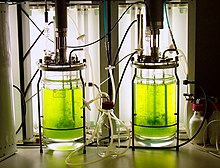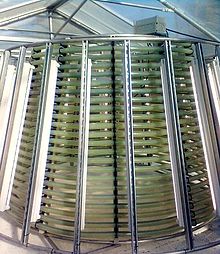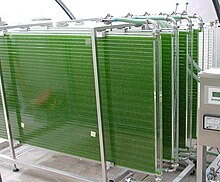User:Sugandhi.G/sandbox
PHOTOBIOREACTOR[edit]
The photobioreactor (PBR) is a specialised bioreactor designed to provide optimal illumination, mixing, CO2 mass transfer, and nutrients to the liquid suspension of phototropic culture. These organisms perform photosynthesis to generate biomass from light and carbon dioxide.[1] They include plants, mosses, micro-algae, cyanobacteria and purple bacteria. Thus, a photobioreactor allows much higher growth rates and purity levels than anywhere in nature or habitats similar to nature. Hypothetically, phototropic biomass could be derived from nutrient-rich wastewater and flue gas carbon dioxide in a photobioreactor. Industrial size photobioreactors are efficient large-volume photobioreactors that are needed to exploit the photosynthetic microorganisms used for making food products. Scale-up problems associated with proper light distribution within the reactor are addressed with this novel reactor design. Their use is rather limited for SCP production because of low throughputs.
Importance of Light[edit]

Exposure of light can be done outdoor using the sun as source or indoor using artificial lighting. Exposure of photosynthetic cells to an excessive amount of light could lead to photo inhibition and to a decrease in the growth rate. On the other hand, the self‐shading effect between individual cells presented in mass cultures of microalgae causes a productivity decrease, even when the amount of light is sufficient for the population of microalgae in the PBR. The quality of light, which means the light wavelength that is used in photosynthesis by the microalgae cultures, also affects the culture performance. During batch culture, or where light is constant, cells can experience photoinhibition at the beginning of the culture, and the limitation of light when a high cell concentration is reached. This can be avoided using fed batch cultivation or continuous culture mode.
General Design[edit]
The fundamental principle for photobioreactor design is a high surface area to volume ratio in order to use light energy efficiently, and is a requirement to obtain high values of photon conversion efficiency (PCE). Higher photosynthetic efficiency can result in higher biomass productivity and concentration, but at much higher cost because of high energy use (mixing, cooling, and embodied energy) and capital cost. Photobioreactor design must include a short light path, which can be obtained using different geometries and low levels of liquid to minimize the energy used for mixing the culture. At a high liquid level, the water column could generate high hydrostatic pressure and require higher energy input for mixing of the culture inside the PBR with air injection.
Types of Photobioreactors[edit]
Open pond systems[edit]
The first approach for the controlled production of phototrophic organisms was a natural open pond or artificial raceway pond. Normally, large scale mass cultivation of microalgae and cyanobacteria is done in shallow open ponds tanks, of circular or raceway type, with solar light.
Design
It is an artificial pond divided into a rectangular grid. It consists of a pond made of cement lined with an epoxy resin and covered with a polyethylene dome. The agitation system is a paddlewheel. It has been used to produce Spirulina biomass. Each rectangle contains a powered paddle wheel to make the water flow continuously around the circuit. The culture suspension, which contains all necessary nutrients and carbon dioxide, is pumped around in a cycle, being directly illuminated from sunlight via the liquid’s surface. This construction principle is the simplest way of production for phototrophic organisms.

Enclosing a pond with a transparent or translucent barrier like a polyethylene dome effectively turns it into a greenhouse. This solves many of the problems associated with an open system. It allows more species to be grown, it allows the species that are being grown to stay dominant, and it extends the growing season – if heated, the pond can produce year round.
Advantages of open pond system
Open pond systems are cheaper to construct, at the minimum requiring only a trench or pond and are also easy to build and operate. Large ponds have the largest production capacities relative to other systems of comparable cost. Open pond cultivation can exploit unusual conditions that suit only specific algae. For instance, Dunaliella salina grow in extremely salty water; these unusual media exclude other types of organisms, allowing the growth of pure cultures in open ponds.[2] Open culture can also work if there is a system of harvesting only the desired algae, or if the ponds are frequently re-inoculated before invasive organisms can multiply significantly. The latter approach is frequently employed by Chlorella farmers, as the growth conditions for Chlorella do not exclude competing algae.
Disadvantages of open pond systems
Open ponds are highly vulnerable to contamination by other microorganisms, such as other algal species or bacteria. Thus cultivators usually choose closed systems for monocultures. Open systems also do not offer control over temperature and lighting. The growing season is largely dependent on location and, aside from tropical areas, is limited to the warmer months. Light reflection and incidence of light occurs at the peak hours of the day when the sun is in the summit due to the incidence angle of light on the surface.
But due to their depth (up to 0.3 m) and the related reduced average light supply, open systems only reach limited area productivity rates. The scaling up of open ponds culture systems can only be performed by increasing the area, because increasing depth will not increase light penetration leading to lower productivities. In addition, the consumption of energy is relatively high, as high amounts of water containing low product concentration have to be processed and the rate of transfer of CO2 mass from the atmosphere is low. Open space is expensive in areas with a dense population, while water is rare in others. Using open technologies causes high losses of water due to evaporation into the atmosphere.
Closed photobioreactor[edit]
Closed photobioreactors are flexible systems that can be optimized according to the biological and physiological characteristics of the microalgal species involved. Several approaches have been conducted since the 1950s to develop closed systems, which theoretically provide higher cell densities of phototrophic organisms and therefore a lower demand of water to be pumped than open systems. In addition, closed construction avoids system-related water losses and the risk of contamination through landing water birds or dust is minimized. All modern photobioreactors try to balance between a thin layer of culture suspension, optimized light application, low pumping energy consumption, capital expenditure and microbial purity. [3]

Since these systems are closed, all essential nutrients must be introduced into the system to allow the microorganisms to grow and be cultivated. A photobioreactor can be operated in "batch mode" which involves restocking the reactor after each harvest, but it is also possible to grow and harvest continuously. Sterilized water, nutrients, air, and carbon dioxide are provided at the correct rates. As the microbes grow, excess culture overflows and is harvested. If sufficient care is not taken, continuous bioreactors can collapse very quickly, but once they are successfully started, they can continue operating for long periods.
They can hold the culture in suspension, or they can provide a substrate on which the culture can form a biofilm. Biofilm-based PBRs have the advantage that they can produce far higher yields for a given water volume, but they can suffer from problems with cells separating from the substrate due to the water flow required to transport gases and nutrients to the culture.[4] Biofilm PBRs include packed bed and porous substrate PBRs. Packed bed PBRs can be different shapes, including flat plate or tubular. In Porous Substrate Bioreactors (PSBRs), the biofilm is exposed directly to the air and receives its water and nutrients by capillary action through the substrate itself. This avoids problems with cells becoming suspended because there is no water flow across the biofilm surface. The culture could become contaminated by airborne organisms, but defending against other organisms is one of the functions of a biofilm.
Any light absorbed by the photobioreactor walls or by the culture and not used in photosynthesis is converted into thermal energy, and may cause an increase of the culture temperature, resulting in culture failure even with tolerant species. Among the solutions experimented with to control overheating in outdoor photobioreactors are water-bath immersion and water spraying.
Advantages
- Reproducible cultivation conditions with regard to environmental influences
- Reduced risk of contamination
- Low CO2 losses
- Smaller area requirements.
Disadvantages
- More difficult to clean
- The tube material might partially decrease sunlight penetration
- The system must be cooled and degassed effectively since any excessive oxygen produced by the growing cultures can reduce growth.
Types of closed photobioreactors[edit]
Semi closed type[edit]
An innovative design is based on the use of oval plastic bags floating on thermal waters or hanging plastic bags mixed with air. The simplest cultivation system is an illuminated bag containing the microalgal suspension, mixed by a stream of CO2-enriched air.
Tubular photobioreactors[edit]

Made from glass or plastic tubes, this photobioreactor type showed successful production. Tubular photobioreactors are established globally from laboratory up to production scale. For example, it is used for the production of the carotenoid Astaxanthin from the green algae Haematococcus pluvialis or for the production of food supplement from the green algae Chlorella vulgaris. These photobioreactors have high purity levels and efficient outputs. The biomass production can be done at a high quality level and the high biomass concentration at the end of the production allows energy efficient downstream processing. The advantages of tubular photobioreactors at production scale are also transferred to laboratory scale. A combination of the mentioned glass vessel with a thin tube coil allows relevant biomass production rates at laboratory research scale. Being controlled by a complex process control system the regulation of the environmental conditions reaches a high level.[5]
Design
Large photobioreactor systems operating outdoors consist of tubes covering large areas exposed to sunlight and can be operated either in batch or continuously. The tubes have diameters ranging from 3 to 6 cm, and lengths ranging from 10 to 100 m. The culture liquid is pumped through these tubes by means of mechanical or air-lift pumps. Tubular photobioreactors consist of straight, coiled, or looped transparent tubing laid out in a specific geometric arrangement designed to maximize light capture. The tubular reactor is connected together to a pipe system. CO2 supply systems, such as carbonation towers, pumps for circulating the medium, and tanks to mix nutrients are attached to the solar receptors. The culture-suspended fluid is able to circulate in this tubing. Tubes are made of either transparent plastics such as polyethylene, polycarbonate or borosilicate glass and the constant circulation is kept up by a pump at the end of the system. The introduction of gas takes place at the end or beginning of the tube system. This way of introducing gas causes the problem of deficiency of carbon dioxide, high concentration of oxygen at the end of the unit during the circulation, and bad efficiency.
Since the tubes behave as solar collectors, overheating is a resulting problem. Hence, the tubular solar receptors must have a temperature-control system, which usually is a water pool. Alternatively, thermotolerant strains can be used to avoid cooling facilities. These photobioreactors have been used for the production of Chlorella, Spirulina, Scenedesmus, and so on.
Vertical column reactor[edit]
Vertical column reactor has a transparent column (for adequate entry of light) surrounded by a water jacket (maintain the temperature of circulating water) and at the top, it bears an inlet for the medium supplementation and an outlet for the gaseous release. Microorganisms such as cyanobacteria are inoculated via septum to prevent the contamination. At the bottom of the vertical-column reactor, there are outlets for the culture and an inlet/outlet for gas. Vertical-column photobioreactors are relatively simple systems in which mixing is achieved by air and carbon dioxide bubbling up from the bottom.
Appropriate design of vertical tubular PBRs can reduce the culture area and distribute photosynthetic organisms in vertical columns. Vertical reactors can increase the exposure of the organisms to light, and also the contact time between gas and liquid, thus increasing residence time of CO2 and the efficiency of CO2 assimilation. Vertical columns can be compact, low cost, easy to operate aseptically, and very promising for large scale culture. But vertical form can generate hydrodynamic and shear stress if the height of the PBR is too large.
Horizontal column reactor[edit]
Horizontally displayed tubular PBRs are considered appropriate for mass cultivation of microalgae because they possess a large illuminated area and have better usage of light at sun summit.
Inclined tubular PBR[edit]
Formerly described designs are combined in inclined tubular PBRs, which have lower hydrodynamic stress and better illumination because the incidence light angle can be adjusted with the inclination of the PBR, also mixing is better than in horizontal tubular PBRs.
Christmas tree photobioreactor[edit]

An alternative approach is shown by a photobioreactor, which is built in a tapered geometry and which carries a helically attached, translucent double hose circuit system.[6] The result is a layout similar to a Christmas tree.[7] The tubular system is constructed in modules and can theoretically be scaled outdoors up to agricultural scale. A dedicated location is not crucial, similar to other closed systems, and therefore non-arable land is suitable as well. The material choice should prevent biofouling and ensure high final biomass concentrations. The combination of turbulence and the closed concept should allow a clean operation and a high operational availability.
Plate photobioreactor[edit]

Another development approach can be seen with the construction based on plastic or glass plates. Plates with different technical design are mounted to form a small layer of culture suspension, which provides an optimized light supply.[8] In addition, the simpler construction compared to tubular reactors allows the use of less expensive plastic materials. From the pool of different concepts e.g. meandering flow designs or bottom gassed systems have been realized and shown good output results. Some unsolved issues are material life time stability or the biofilm forming. Applications at industrial scale are limited by the scalability of plate systems.

Flat photobioreactors are developed as transparent flat-panels connected in series, vertically-arranged 20 cm apart. Compared with tubular systems, flat-panel photobioreactors have one serious disadvantage: a fouling up of the channels due to reduced turbulence in their narrow, rectangular shape channels.
Foil photobioreactor[edit]
The pressure of market prices has led the development of foil-based photobioreactor types. Inexpensive PVC or PE foils are mounted to form bags or vessels which cover algae suspensions and expose them to light. The pricing ranges of photobioreactor types have been enlarged with the foil systems.[9] It has to be kept in mind, that these systems have a limited sustainability as the foils have to be replaced from time to time. For full balances, the investment for required support systems has to be calculated as well.
Porous Substrate Bioreactor[edit]
Porous Substrate Bioreactor (PSBR), being developed at University of Cologne, also known as the twin-layer system, uses a new principle to separate the algae from a nutrient solution by means of a porous reactor surface on which the microalgae are trapped in biofilms. This new procedure reduces by a factor of up to one hundred the amount of liquid needed for operation compared to the current technology, which cultivates algae in suspensions. As such, the PSBR procedure significantly reduces the energy needed while increasing the portfolio of algae that can be cultivated.
CHALLENGES OF USING PHOTOBIOREACTORS[edit]
The traditional bioreactor designs face challenges in delivering process efficiencies. Challenges using a photobioreactor include [10]:
- Precisely controlling light intensity and temperature simultaneously.
- CO2 and gas diffusion constants.
- pH adjustment in real-time.
- Culture mixing.
- Nutrient addition.
- Evaporation and water loss.
- Maintaing sterility.
- Algae collection and aggregation.
- Scale-ability and space requirements.
APPLICATIONS OF PHOTOBIOREACTORS[edit]
Applications for photobioreactors include growing algae and cyanobacteria for biofuels, bioplastics, pharmaceuticals, nutriceuticals, food additives, carbon capture, and waste water remediation.
- They are quite adequate for the production of algal metabolites with high added value, such as polysaccharides, carotenes, and other pigments, polyunsaturated fatty acids, and so on.
- Culturing Macro and Micro Algae
- Culturing Cyanobacteria and purple bacteria
- Culturing Seaweed, plant cells, and bryophytes
- Waste water remediation
- Hydrogen gas production (biorefineries)
- Using Algal alcohols and oils as biofuels
- Production of Biomolecules (polysaccharides, amino acids, isoprenoids, phenols, etc…)
- Bioplastics, organic renewable replacements for petrochemical products
- Aquaculture (animal feed, human nutrition, value added products)
- Carbon Capture (sinking carbon to mitigate climate change)
- Pharmaceutical applications include drug discovery, bioactive molecules, vaccine production, etc…
REFERENCES[edit]
- ^ http://www.oilgae.com/ref/glos/photobioreactor.html
- ^ https://www.frontiersin.org/articles/10.3389/fenrg.2016.00029/full
- ^ https://www.sciencedirect.com/topics/immunology-and-microbiology/photobioreactor
- ^ https://www.intechopen.com/books/algae-organisms-for-imminent-biotechnology/considerations-for-photobioreactor-design-and-operation-for-mass-cultivation-of-microalgae
- ^ http://www.algaeobserver.com/igv-algae-screening-xcubio
- ^ F. Cotta, M. Matschke, J. Großmann, C. Griehl und S. Matthes; "Verfahrenstechnische Aspekte eines flexiblen, tubulären Systems zur Algenproduktion" (Process-related aspects of a flexible, tubular system for algae production); DECHEMA 2011
- ^ Großmann Ingenieur Consult GmbH: Aufbau eines Biosolarzentrums in Köthen, 6. März 2011.
- ^ Handbook of microalgal culture. Vol. 1 (2nd ed.). Blackwell Science Ltd. 2013. ISBN 978-0-470-67389-8.
- ^ Zittelli, Graziella; Liliana Rodolfi; Niccolo Bassi; Natascia Biondi; Mario R. Tredici (2012). "Chapter 7 Photobioreactors for Microalgae Biofuel Production". In Michael A. Borowitzka, Navid R. Moheimani (ed.). Algae for Biofuels and Energy. Springer Science & Business Media. pp. 120–121. ISBN 9789400754799.
- ^ https://solarisbiotechusa.com/photobioreactors-optimize-phototrophic-bioprocess
